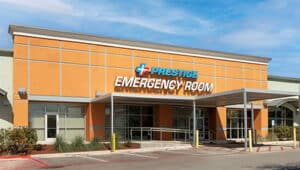What Are Pediatric Infections?
Pediatric infectious diseases are illnesses in children caused by bacteria, viruses, fungi, or parasites. They range from mild to severe and may require urgent or specialized medical care. The most common pediatric infections include:
- Ear infections.
- Respiratory Syncytial Virus (RSV).
- Strep throat.
- Hand, foot, and mouth disease.
- Chickenpox (Varicella).
- Flu (Influenza).
- Common cold.
- Pink eye (Conjunctivitis).
- Pneumonia
- Gastroenteritis.
Symptoms of Pediatric Infections
Common signs and symptoms of pediatric infections include:
- Fever, chills, and sweats.
- Sore throat and mouth.
- Runny nose and congestion.
- Body aches and muscle pain.
- Skin rash.
- Fatigue.
- Loss of appetite.
- Nausea or vomiting.
- Abdominal pain and diarrhea.
- Cloudy or foamy urine.
Common Causes of Pediatric Infections
Most children’s infections are caused by bacteria or viruses that can spread through direct contact, indirect contact, or inhaling airborne droplets.
- Direct contact
The infection is caused by physical contact (e.g., touching, kissing, or sharing personal items) with an infected person. - Indirect contact
The infection is caused by touching a contaminated surface or object (e.g., doorknob, railing, faucet, or light switch) an infected person previously touched. - Airborne droplets
The infection is caused by inhaling bacteria or viruses released into the air when an infected person coughs, sneezes, laughs, or exhales.
Diagnosis of Pediatric Infections
Pediatric infectious diseases are diagnosed through physical examination, medical history, laboratory testing, and more.
Medical History Review
A medical history is necessary to help your physician identify possible causes and determine which tests are required to confirm the diagnosis.
Physical Examination
During a physical exam, a pediatric infectious disease specialist will assess your child’s general appearance, including vital signs (e.g., heart rate, blood pressure, respiratory rates, etc.), head, eyes, ears, nose, and throat. They will also assess their respiratory and cardiovascular systems, as well as their abdomen, skin, and lymph nodes.
Laboratory Tests
Common pediatric tests include:
- Blood tests (e.g., complete blood count and C-reactive panel).
- Urine analysis.
- Stool cultures.
- Throat swabs.
Imaging Studies
Depending on the suspected site of infection, one or more of the following imaging studies may be used:
- Ultrasound.
- Chest X-ray.
- Computed tomography (CT).
Ultrasounds are often the first choice for initial evaluations due to their accessibility and lack of radiation exposure. However, CTs and MRIs may be used in more complex cases.
Specialized Testing
If your doctor requires more detailed or specialized testing to make an accurate diagnosis, they may recommend one or more of the following:
- Culture and sensitivity to identify the pathogen and determine the best antibiotic treatment.
- PCR testing for rapid detection, analysis, and treatment.
- Serology testing to detect pre-existing antibodies.
- Rapid diagnostic testing to quickly diagnose and treat influenza or strep throat.
- Molecular diagnostics to identify a broad range of pathogens at the same time.
Treatment for Pediatric Infections
At Prestige ER, our pediatric emergency room offers several effective options to treat infectious diseases in children. However, they vary depending on the type of infection and its severity. Common treatments include:
- Antibiotics (for bacterial infections).
- Antiviral medications (for viral infections).
- Pain relief medications (to reduce pain and fever).
- Supportive care to alleviate symptoms (e.g., fluids, rest, warm compress, or oxygen therapy as needed).
When to Go to the ER for Pediatric Infections
If your child has a fever over 102 degrees Fahrenheit for two days or more, visit your nearest emergency room for immediate care, especially if it is accompanied by other concerning symptoms. These may include one or more of the following:
- Difficulty breathing or rapid breathing.
- Severe pain (e.g., abdomen, ear, head, etc.)
- Stiff neck.
- Widespread rash.
- Lethargy or difficulty waking up.
- Signs of dehydration.
- Confusion or altered mental state.
Note: A doctor should immediately evaluate any fever in an infant under three months old.
Why Choose Prestige ER for Pediatric Infectious Disease Care
Childhood infectious diseases can be alarming, but timely care can help your child avoid severe complications. By understanding the signs and symptoms and when to seek emergency care, you can give your child the support they need to recover and feel like themselves again fast.
Prestige ER is available 24 hours a day, 365 days a year, for patients throughout the San Antonio, TX, area. Find a location nearest you and get the care you need and deserve today.












